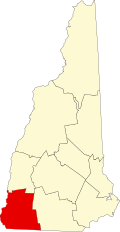Elbridge G. Bemis House | |
 | |
| Location | Chesham Rd., Harrisville, New Hampshire |
|---|---|
| Coordinates | 42°56′14″N72°8′33″W / 42.93722°N 72.14250°W |
| Area | 0.5 acres (0.20 ha) |
| Built | 1855 |
| Architectural style | Greek Revival |
| MPS | Harrisville MRA |
| NRHP reference No. | 86003247 [1] |
| Added to NRHP | January 14, 1988 |
The Elbridge G. Bemis House is a historic house on Chesham Road in Harrisville, New Hampshire. The two-story Greek Revival frame house is one of a pair of houses built for the Bemis brothers (the other is the nearby George Bemis House), and is one of a few well-preserved houses of that period in the town. The house was listed on the National Register of Historic Places in 1988. [1]


